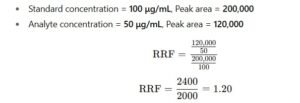Relative Response Factor (RRF) and its Calculation in HPLC Analysis

1. What is Relative Response Factor (RRF)?
-
Definition: The Relative Response Factor is the ratio of the detector response of an analyte to that of a reference standard (usually the active ingredient or an internal standard), under identical chromatographic conditions.
-
It compensates for differences in detector sensitivity towards different compounds.
-
RRF is particularly important when the impurity standard is not available in pure form, and quantification is done using the main compound’s standard.
2. Formula for RRF
3. Steps to Calculate RRF in HPLC
-
Prepare solutions of the analyte and the reference standard at known concentrations.
-
Inject both under identical HPLC conditions.
-
Record the peak areas from the chromatogram.
-
Apply the RRF formula to determine the value.
-
Use this RRF to correct results when quantifying impurities without individual reference standards.
4. Example Calculation

Interpretation: The analyte gives 20% higher detector response than the standard per unit concentration.
5. Applications of RRF
-
Quantification of impurities when no pure impurity standards are available.
-
Ensuring accuracy in related substance tests.
-
Regulatory submissions (ICH Q3A/B, Q2 guidelines).


